Recently Discovered Thick Bentonite Bed Hosted by the Lithothamnium Limestones (Badenian) in the Polish Part of the Carpathian Foredeep: The Evidence for Volcanic Origin
Abstract
:1. Introduction
2. Geology
3. Material
4. Methods
5. Results
5.1. Hand Specimen Examination
5.2. X-ray Powder Diffraction
5.3. Optical Microscopy
5.4. Field Emission Gun Scanning Electron Microscopy (FESEM)
6. Discussion
6.1. Preservation of Volcanic Markers in the Clay Interbedded with Lithothamnium Limestone in the Drugnia Rządowa
6.2. Peculiarity of the Bentonite Bed
6.3. Possible Location of the Source Volcanoes
6.4. Some Remarks on the Use of the Bentonite as Raw Materials
7. Concluding Remarks
Author Contributions
Funding
Data Availability Statement
Acknowledgments
Conflicts of Interest
References
- Flügel, E. Microfacies of Carbonate Rocks: Analysis, Interpretation and Application, 1st ed.; Springer: Berlin/Heidelberg, Germany, 2004; p. 976. [Google Scholar] [CrossRef]
- Chamley, H. Clay Sedimentology; Springer: Berlin/Heidelberg, Germany, 1989; p. 623. [Google Scholar] [CrossRef]
- Grim, R.E.; Güven, N. Bentonites. Geology, Mineralogy, Properties and Uses; Developments in Sedimentology; Elsevier: Amsterdam, The Netherlands, 1978; Volume 24, p. 256. [Google Scholar]
- Fisher, R.V.; Schmincke, H.-U. Pyroclastic Rocks; Springer: Berlin/Heidelberg, Germany, 1984; p. 484. [Google Scholar] [CrossRef]
- Tribble, J.S.; Wilkens, R.H. Microfabric of Altered Ash Layers, ODP Leg 131, Nankai Trough. Clays Clay Miner. 1994, 42, 428–436. [Google Scholar] [CrossRef]
- Weaver, C.E. Interpretative value of heavy minerals from bentonites. J. Sediment. Res. 1963, 33, 343–349. [Google Scholar]
- Bohor, B.F.; Triplehorn, D.M. Tonsteins: Altered Volcanic-Ash Layers in Coal-Bearing Sequences. Geol. Soc. Am. Spec. Pap. 1993, 285, 1–44. [Google Scholar]
- Christidis, G.E.; Huff, W.D. Geological Aspects and Genesis of Bentonites. Elements 2009, 5, 93–98. [Google Scholar] [CrossRef]
- Murray, H.H. Applied Clay Mineralogy. Occurrences, Processing and Application of Kaolins, Bentonites, Palygorskite-Sepiolite, and Common Clays; Developments in Clay Science 2; Elsevier: Amsterdam, The Netherlands, 2007; p. 180. [Google Scholar]
- Murray, H.H. Clay sorbents: The mineralogy, processing and applications. Acta Geodyn. Geomater. 2005, 2, 131–138. [Google Scholar]
- Eisenhour, D.D.; Brown, R.K. Bentonite and its Impact on Modern Life. Elements 2009, 5, 83–88. [Google Scholar] [CrossRef]
- Harangi, S.; Lenkey, L. Genesis of the Neogene to Quaternary volcanism in the Carpathian-Pannonian region: Role of subduction, extension, and mantle plume. Geol. Soc. Am. Spec. Pap. 2007, 418, 67–92. [Google Scholar] [CrossRef] [Green Version]
- Lexa, J.; Seghedi, I.; Németh, K.; Szakács, A.; Konečný, V.; Pécskay, Z.; Fülöp, A.; Kovacs, M. Neogene-Quaternary Volcanic forms in the Carpathian-Pannonian Region: A review. Cent. Eur. J. Geosci. 2010, 2, 207–270. [Google Scholar] [CrossRef] [Green Version]
- Lukács, R.; Harangi, S.; Guillong, M.; Bachmann, O.; Fodora, L.; Buret, J.; Dunkl, I.; Sliwinski, J.; von Quadt, A.; Peytcheva, I.; et al. Early to Mid-Miocene syn-extensional massive silicic volcanism in the Pannonian Basin (East-Central Europe): Eruption chronology, correlation potential and geodynamic implications. Earth Sci. Rev. 2018, 179, 1–19. [Google Scholar] [CrossRef]
- Rocholl, A.; Schaltegger, U.; Gilg, H.A.; Wijbrans, J.; Böhme, M. The age of volcanic tuffs from the Upper Freshwater Molasse (North Alpine Foreland Basin) and their possible use for tephrostratigraphic correlations across Europe for the Middle Miocene. Int. J. Earth Sci. 2018, 107, 387–407. [Google Scholar] [CrossRef]
- Alexandrowicz, S.W. Lithostratigraphy of the Miocene deposits in the Gliwice area (Upper Silesia, Poland). Bull. Pol. Acad. Earth Sci. 1997, 45, 167–179. [Google Scholar]
- Czapowski, G. Magmatyzm. In Budowa Geologiczna Polski. T.1. Stratygrafia, cz. 3a. Kenozoik: Paleogen i Neogen; Peryt, T.M., Piwocki, M., Eds.; Państwowy Instytut Geologiczny: Warszawa, Poland, 2004; pp. 251–254. [Google Scholar]
- Instytut Geologiczny. Mapa Geologiczna Regionu Świętokrzyskiego bez Utworów Czwartorzędowych w Skali 1:200,000; Wydawnictwa Geologiczne: Warszawa, Poland, 1961. [Google Scholar]
- Radwański, A. Transgresja dolnego tortonu na południowo-wschodnich i wschodnich stokach Gór Świętokrzyskich. Lower Tortonian transgression onto the south-eastern and eastern slopes of the Holy Cross Mts. Acta Geol. Pol. 1973, 23, 375–434. [Google Scholar]
- Głogoczowski, J.J. Niektóre własności bentonitów i iłów bentonitowych z Chmielnika. Rocz. Pol. Tow. Geol. 1957, 27, 195–220. [Google Scholar]
- Wyszomirski, P.; Lewicka, E. Bentonity jako uniwersalny surowiec wielu dziedzin przemysłu. Gosp. Surowcami Min. 2005, 21, 5–19. [Google Scholar]
- Górniak, K.; Szydłak, T.; Gaweł, A.; Klimek, A.; Tomczyk, A.; Motyka, J.; Bahranowski, K. Bentonite from the Central Slovakia Volcanic Field—A prospective raw material for Polish industry. Mineralogia 2017, 48, 23–48. [Google Scholar] [CrossRef]
- Czarnocki, J. Sprawozdanie z badań terenowych wykonanych w Górach Świętokrzyskich w 1938 r. Inst. Geol. Biul. 1939, 15, 11–13. [Google Scholar]
- Fijałkowska, E.; Fijałkowski, J. Bentonity w utworach miocenu południowego obrzeżenia Gór Świętokrzyskich. Bentonites in Miocene deposits of the southern margin of the Święty Krzyż Mountains. Inst. Geol. Biul. 1966, 164, 95–129. [Google Scholar]
- Ratajczak, T.; Górniak, K.; Bahranowski, K.; Szydłak, T. Clay minerals as evidence of volcanic activity during the Miocene sedimentationin the NE part of the Carpathian Foredeep (Poland). Geol. Carpath.-Ser. Clays 1993, 44, 81–92. [Google Scholar]
- Czapowski, G. Otoczenie Gór Świętokrzyskich. In Budowa Geologiczna Polski. T.1. Stratygrafia, cz. 3a. Kenozoik: Paleogen i Neogen; Peryt, T.M., Piwocki, M., Eds.; Państwowy Instytut Geologiczny: Warszawa, Poland, 2004; pp. 239–245. [Google Scholar]
- Oszczypko, N. Powstanie i rozwój polskiej części zapadliska przedkarpackiego (Development of the Polish sector of the Carpathian Foredeep). Przegl. Geol. 2006, 54, 396–403. [Google Scholar]
- Oszczypko, N.; Krzywiec, P.; Popadyuk, I.; Peryt, T. Carpathian Foredeep Basin (Poland and Ukraine): Its Sedimentary, Structural, and Geodynamic Evolution. In The Carpathians and Their Foreland: Geology and Hydrocarbon Resources; Golonka, J., Picha, F.J., Eds.; AAPG Memoir: The American Association of Petroleum Geologists: Tulsa, OK, USA, 2006; Volume 84, pp. 293–350. [Google Scholar] [CrossRef]
- Wysocka, A.; Radwański, A.; Górka, M.; Bąbel, M.; Radwańska, U.; Złotnik, M. The Middle Miocene of the Fore-Carpathian Basin (Poland, Ukraine and Moldova). Acta Geol. Pol. 2016, 66, 351–401. [Google Scholar] [CrossRef] [Green Version]
- Radwański, A. Transgresja dolnego tortonu na południowych stokach Gór Świętokrzyskich (strefa zatok i ich przedpola). Lower Tortonian transgression onto the southern slopes of the Holy Cross Mts. Acta Geol. Pol. 1969, 19, 1–164. [Google Scholar]
- Alexandrowicz, S.W.; Garlicki, A.; Rutkowski, J. Podstawowe jednostki litostratygraficzne miocenu zapadliska przedkarpackiego. Kwart. Geol. 1982, 26, 470–471. [Google Scholar]
- Czarnocki, J. Helwet i węgiel brunatny tegoż wieku w okolicy Korytnicy i Chomentowa. Posiedzenia Nauk. PIG 1932, 36, 16–25. [Google Scholar]
- Kowalewski, K. Stratygrafia miocenu południowej Polski ze szczególnym uwzględnieniem południowego obrzeżenia Gór Świętokrzyskich (Miocene stratygraphy of southern Poland with special attention paid to the southern margin of the Święty Krzyż Mountains). Kwart. Geol. 1958, 2, 3–43. [Google Scholar]
- Studencki, W. Facies and Sedimentary Environment of the Pińczów Limestones (Middle Miocene; Holy Cross Mountains, Central Poland). Facies 1988, 18, 1–25. [Google Scholar] [CrossRef]
- Studencki, W. Red algae from the Pińczów limestones (Middle Miocene, Swiętokrzyskie Mountains, Poland). Acta Palaeontol. Pol. 1988, 33, 3–57. [Google Scholar]
- Studencki, W. Red-algal limestones in the Middle Miocene of the Carpathian Foredeep in Poland: Facies variability and palaeoclimatic implications. Geol. Quart. 1999, 43, 395–404. [Google Scholar]
- Łaptaś, A. Giant-scale cross-bedded Miocene biocalcarenite in the northern margin of the Carpathian Foredeep. Ann. Soc. Geol. Pol. 1992, 62, 149–167. [Google Scholar]
- Leszczyński, S.; Nemec, W. Dynamic stratigraphy of composite peripheral unconformity in a foredeep basin. Sedimentology 2015, 62, 645–680. [Google Scholar] [CrossRef]
- Heflik, W. Petrografia szkliwa wulkanicznego z iłów bentonitowych w miejscowości Ciecierze koło Chmielnika (Petrography of volcanic glass in bentonite clays from Ciecierze near Chmielnik (Southward from the Święty Krzyż Mts.)). Kwart. Geol. 1959, 3, 778–789. [Google Scholar]
- Langier-Kuźniarowa, A. Bentonity miceńskie z wierceń okolic Szydłowa (woj. kieleckie) (Miocene bentonites from the bore-hole made in Szydłów region (Kielce district)). Inst. Geol. Biul. 1967, 207, 223–250. [Google Scholar]
- Czarnocki, J. Arkusze: Pińczów, Staszów, Działoszyce, Stopnica. In Region Świętokrzyski (1950). Materiały do Przeglądowej Mapy Geologicznej Polski 1:100,000; Instytut Geologiczny: Warszawa, Poland, 1961. [Google Scholar]
- Lazar, R.; Bohacs, K.M.; Schieber, J.; Macquaker, J.; Demko, T.M. Capturing key attributes of fine-grained sedimentary rocks in outcrops, cores, and thin sections: Nomenclature and description guidelines. J. Sediment. Res. 2015, 85, 230–246. [Google Scholar] [CrossRef] [Green Version]
- Munsell Color Company. Munsell Rock Color Book; Munsell Color Company: Grand Rapids, MI, USA, 2009. [Google Scholar]
- Schultz, L.G. Quantitative interpretation of mineralogical composition from X-ray and chemical data for the Pierre Shale. US Geol. Surv. Prof. Pap. 1964, 391-C, 1–30. [Google Scholar] [CrossRef] [Green Version]
- Reynolds, R.C.; Hower, J. The nature of interlayering in mixed-layer illite-montmorillonites. Clays Clay Miner. 1970, 18, 25–36. [Google Scholar] [CrossRef]
- Li, Z.; Schieber, J.; Bish, D. Decoding the origins and sources of clay minerals in the Upper Cretaceous Tununk Shale of south-central Utah: Implications for the pursuit of climate and burial histories. Depos. Rec. 2020, 6, 172–191. [Google Scholar] [CrossRef] [Green Version]
- Huff, W.D.; Kolata, D.R.; Bergström, S.M.; Zhang, Y.-S. Large-magnitude Middle Ordovician volcanic ash falls in North America and Europe: Dimensions, emplacement and post emplacement characteristics. J. Volcanol. Geotherm. Res. 1996, 73, 285–301. [Google Scholar] [CrossRef]
- Khoury, H.N.; Eberl, D.D. Bubble-wall shards altered to montmorillonite. Clays Clay Miner. 1979, 27, 291–292. [Google Scholar] [CrossRef]
- Christidis, G.E. Formation and growth of smectites in bentonites: A case study from Kimolos Island, Aegean, Greece. Clays Clay Miner. 2001, 49, 204–215. [Google Scholar] [CrossRef]
- White, R.J.; Spinelli, G.A.; Mozley, P.S.; Dunbar, N.W. Importance of volcanic glass alteration to sediment stabilization: Offshore Japan. Sedimentology 2011, 58, 1138–1154. [Google Scholar] [CrossRef]
- Fiore, S.; Huertas, F.J.; Huertas, F.; Linares, J. Smectite formation in rhyolitic obsidian as inferred by microscopic (SEM-TEM-AEM) investigation. Clay Miner. 2001, 36, 489–500. [Google Scholar] [CrossRef]
- Wilson, M.D.; Pittman, E.D. Authigenic clays in sandstones: Recognition and influence on reservoir properties and paleoenvironmental analysis. J. Sediment. Petrol. 1977, 47, 3–31. [Google Scholar]
- Deconinck, J.F.; Chamley, H. Diversity of smectite origins in Late Cretaceous sediments: Example of chalks from northern France. Clay Miner. 1995, 30, 365–379. [Google Scholar] [CrossRef]
- Drits, V.A.; Zviagina, B.B. Trans-vacant and cis-vacant 2:1 layer silicates: Structural features, identification, and occurrence. Clays Clay Miner. 2009, 57, 405–415. [Google Scholar] [CrossRef]
- Calarge, L.M.; Lanson, B.; Meunier, A.; Formoso, M.L.L. The smectitic minerals in a bentonite deposit from Melo (Uruguay). Clay Miner. 2003, 38, 25–34. [Google Scholar] [CrossRef] [Green Version]
- Ross, C.S.; Shannon, E.V. The minerals of bentonite and related clays and their physical properties. J. Am. Ceram. Soc. 1926, 9, 77–96. [Google Scholar] [CrossRef]
- Meunier, A.; Lanson, B.; Velde, B. Composition variation of illite-vermiculitesmectite mixed-layer minerals in a bentonite bed from Charente (France). Clay Miner. 2004, 39, 317–332. [Google Scholar] [CrossRef] [Green Version]
- Tokarski, J. The genesis and systematic position of bentonites. Mémoires de l’Académie polonaise des sciences et des lettres: Classe des sciences mathématiques et naturelles. Sci. Naturelles. Série B 1953, 1, 267–270. [Google Scholar]
- Konečný, V.; Lexa, J.; Šimon, L.; Dublan, L. The Neogene volcanism in central Slovakia. Miner. Slovaca 2001, 33, 159–179. [Google Scholar]
- Pécskay, Z.; Lexa, J.; Szakács, A.; Seghedi, I.; Balogh, K.; Konečný, V.; Zelenka, T.; Kovacs, M.; Póka, T.; Fülöp, A.; et al. Geochronology of Neogene magmatism in the Carpathian arc and intra-Carpathian area. Geol. Carpath. 2006, 57, 511–530. [Google Scholar]
- Sarjoughian, F.; Kananian, A.; Ahmadian, J.; Murata, M. Chemical composition of biotite from the Kuh-e Dom pluton, Central Iran: Implication for granitoid magmatism and related Cu–Au mineralization. Arab. J. Geosci. 2015, 8, 1521–1533. [Google Scholar] [CrossRef]
- Kraus, I.; Čičel, B.; Šamajová, E.; Machajdīk, D. Origin and distribution of clays resulting from alteration of rhyolite volcanic rocks in Central Slovakia (Czechoslovakia). Geol. Carpath. 1982, 33, 269–275. [Google Scholar]
- Kraus, I.; Šamajová, E.; Šucha, V.; Lexa, J.; Hroncová, Z. Diagenetic and hydrothermal alterations of volcanic rocks into clay minerals and zeolites (Kremnické Vrchy Mts., the Western Carpathians). Geol. Carpath. 1994, 45, 151–158. [Google Scholar]
- Uhlík, P.; Jánošík, M.; Kraus, I.; Pentrák, M.; Čaplovičová, M. Charakterizácia bentonitu z ložiska Hliník nad Hronom (jastrabská formácia štiavnického stratovulkánu, Západné Karpaty). Acta Geol. Slovaca 2012, 4, 125–137. [Google Scholar]
- Górniak, K.; Szydłak, T.; Gaweł, A.; Klimek, A.; Tomczyk, A.; Sulikowski, B.; Olejniczak, Z.; Motyka, J.; Serwicka, E.M.; Bahranowski, K. Commercial bentonite from the Kopernica deposit (Tertiary, Slovakia): A petrographic and mineralogical approach. Clay Miner. 2016, 51, 97–122. [Google Scholar] [CrossRef]
- Górniak, K.; Szydłak, T.; Gaweł, A.; Klimek, A.; Tomczyk, A.; Motyka, J.; Bahranowski, K. Smectite-silica- and zeolites-bearing raw materials (Hliník nad Hronom bentonite, Slovakia)—A new approach using integrated petrographic and mineralogical studies. Appl. Clay Sci. 2017, 141, 180–191. [Google Scholar] [CrossRef]
- Osacký, M.; Binčík, T.; Paľo, T.; Uhlík, P.; Madejová, J.; Czímerová, A. Mineralogical and physico–chemical properties of bentonites from the Jastrabá Formation (Kremnické vrchy Mts., Western Carpathians). Geol. Carpah. 2019, 70, 433–445. [Google Scholar] [CrossRef]
- Bukowski, K.; de Leeuw, A.; Gonera, M.; Kuiper, K.F.; Krzywiec, P.; Peryt, D. Badenian tuffite levels within the Carpathian orogenic front (Gdów–Bochnia area, Southern Poland): Radio-isotopic dating and stratigraphic position. Geol. Quart. 2010, 54, 449–464. [Google Scholar]
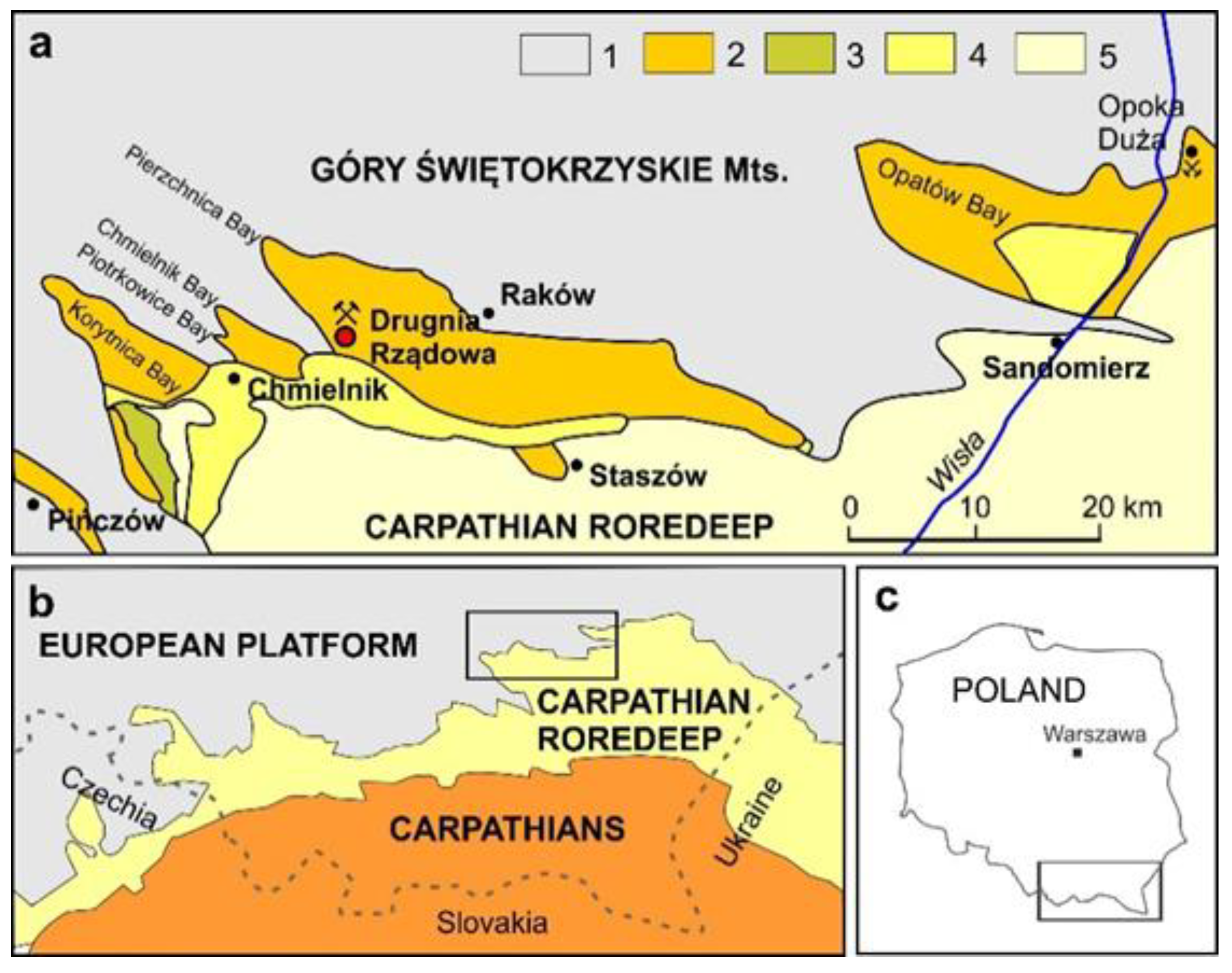
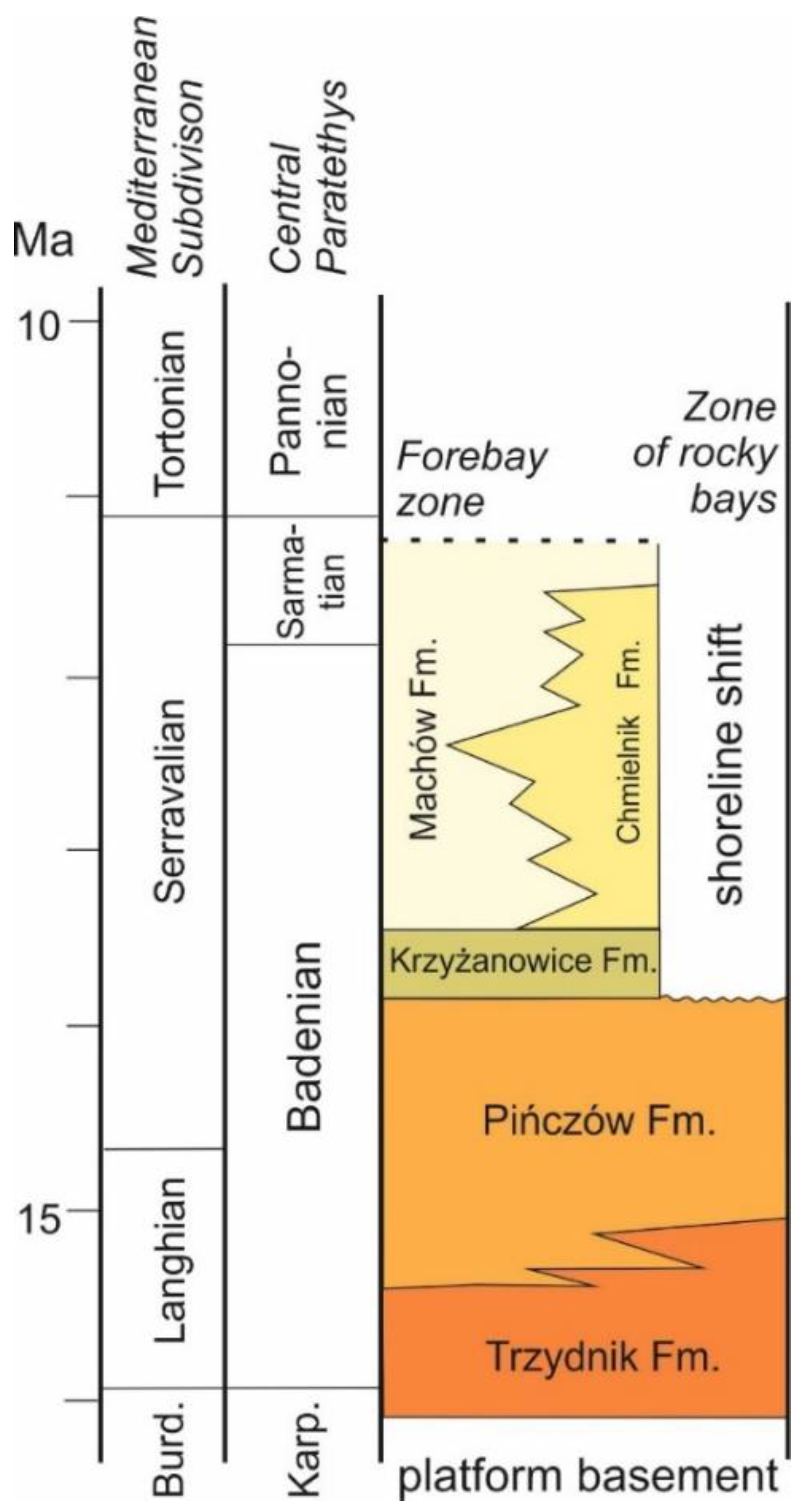
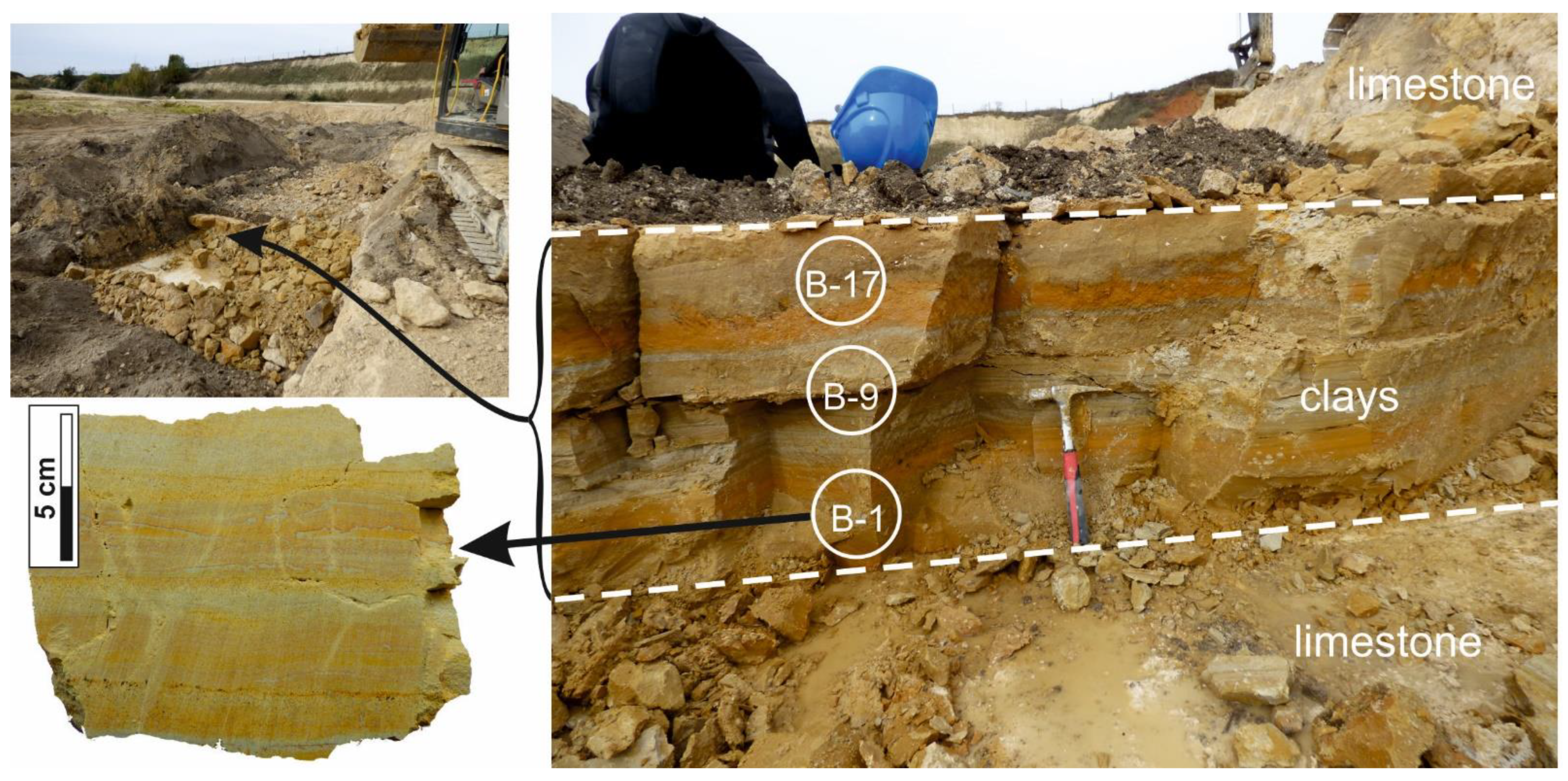
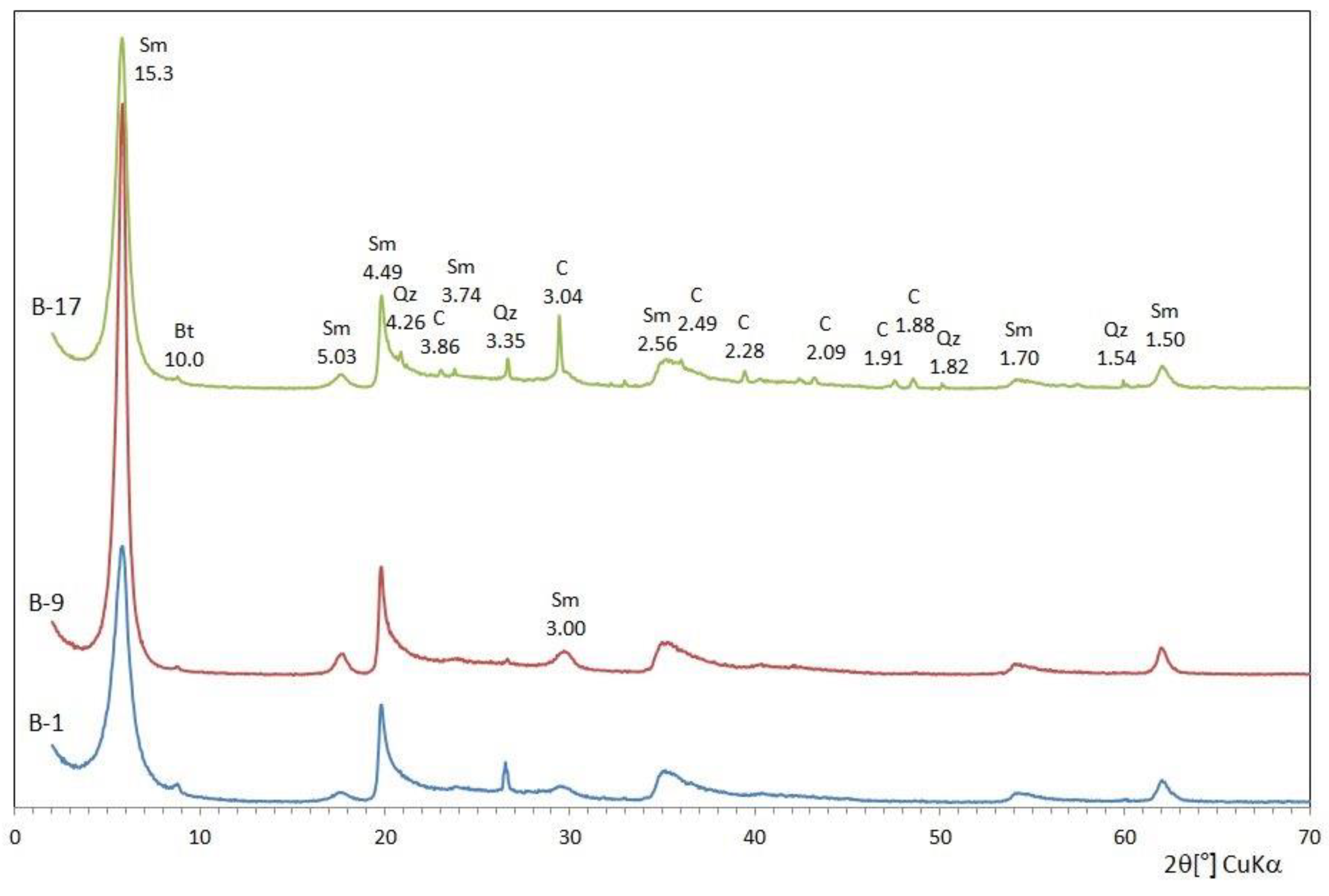
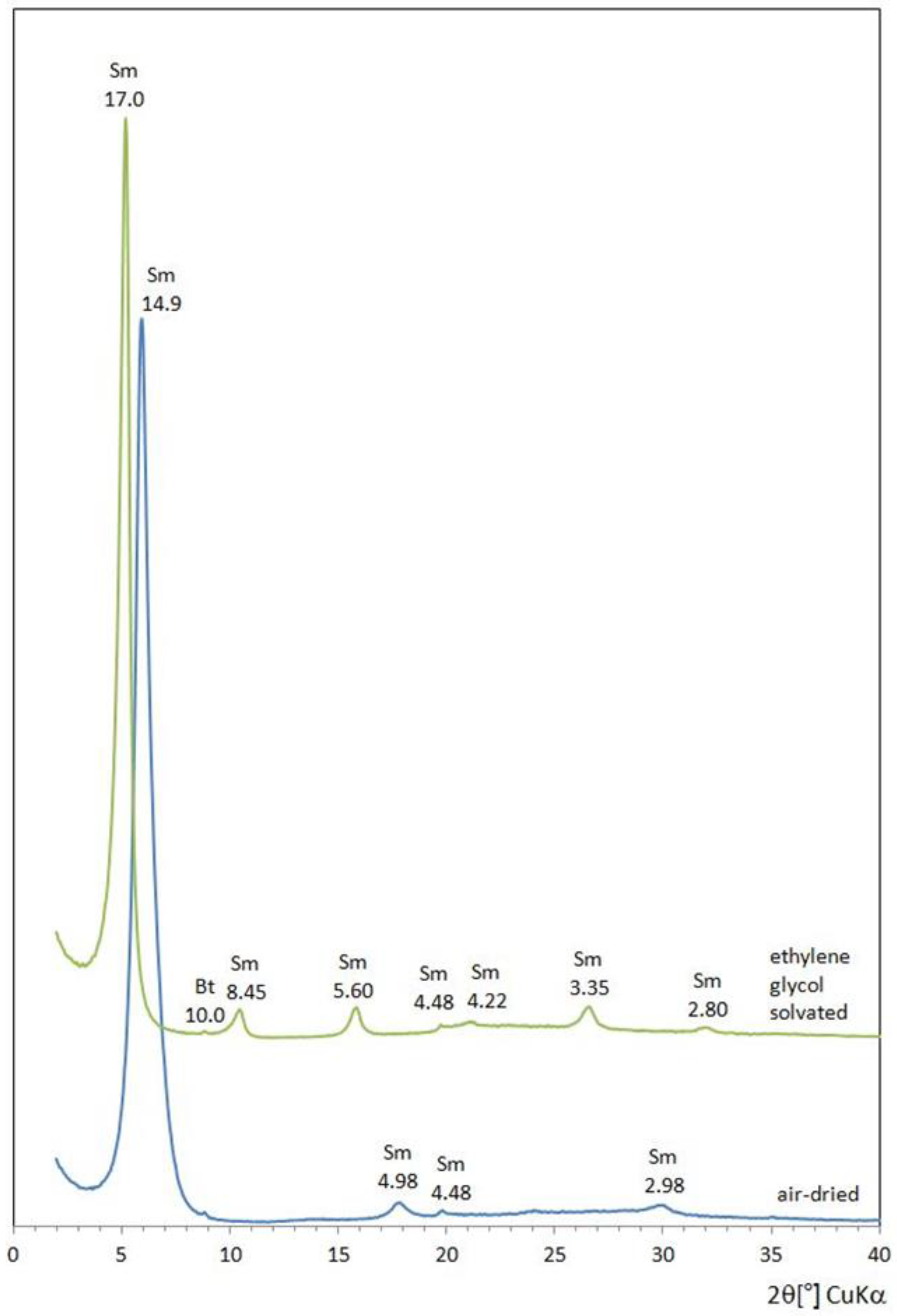
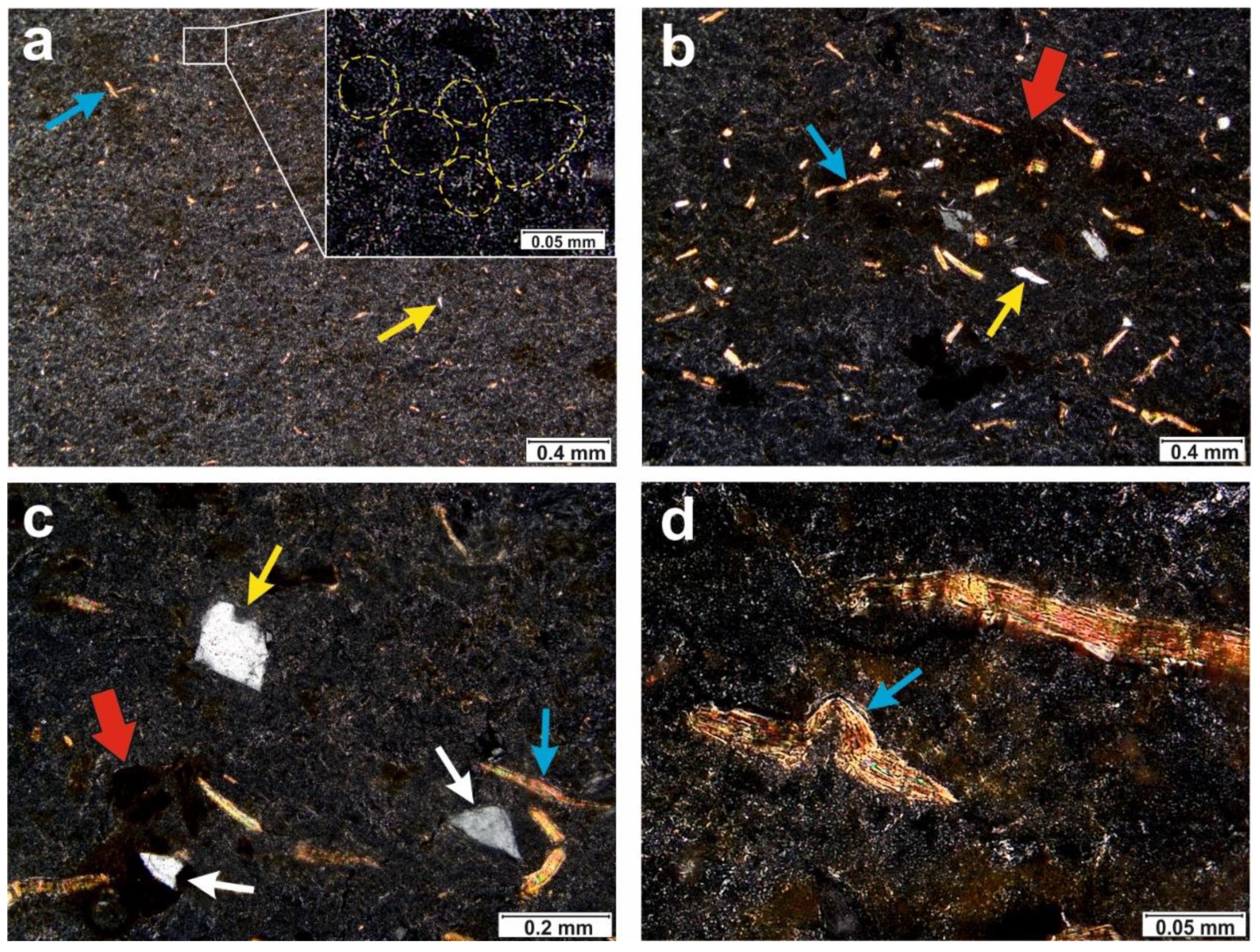
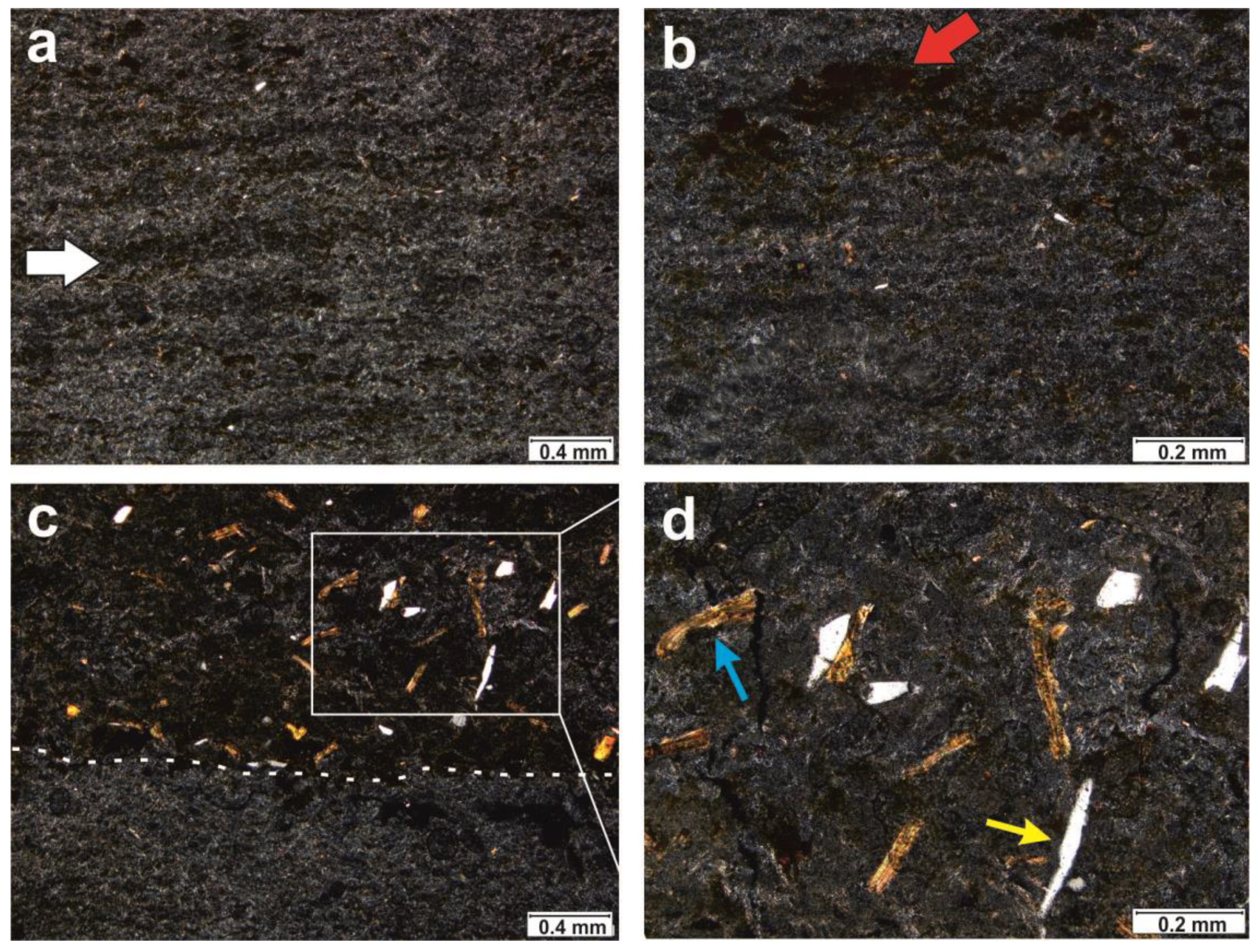
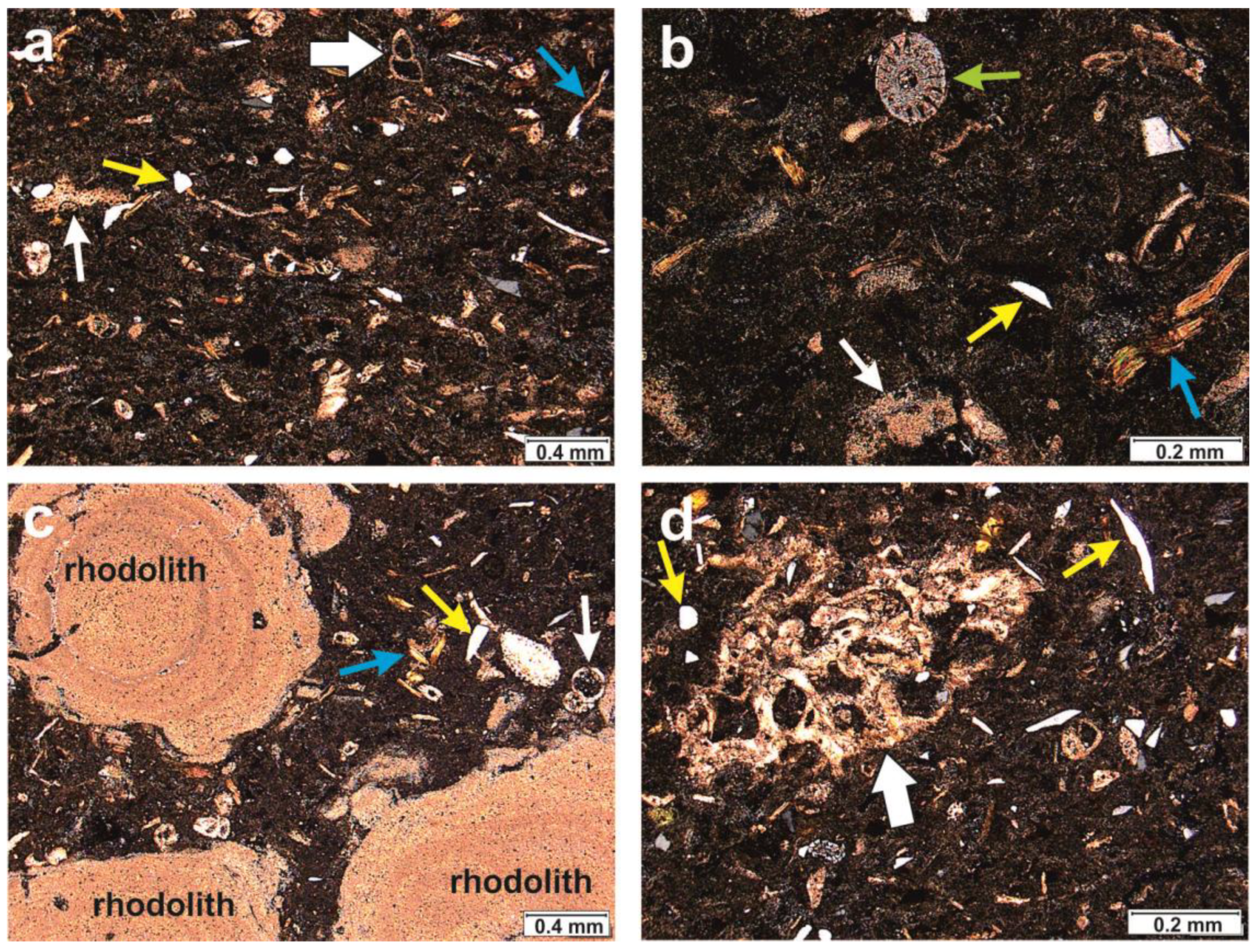
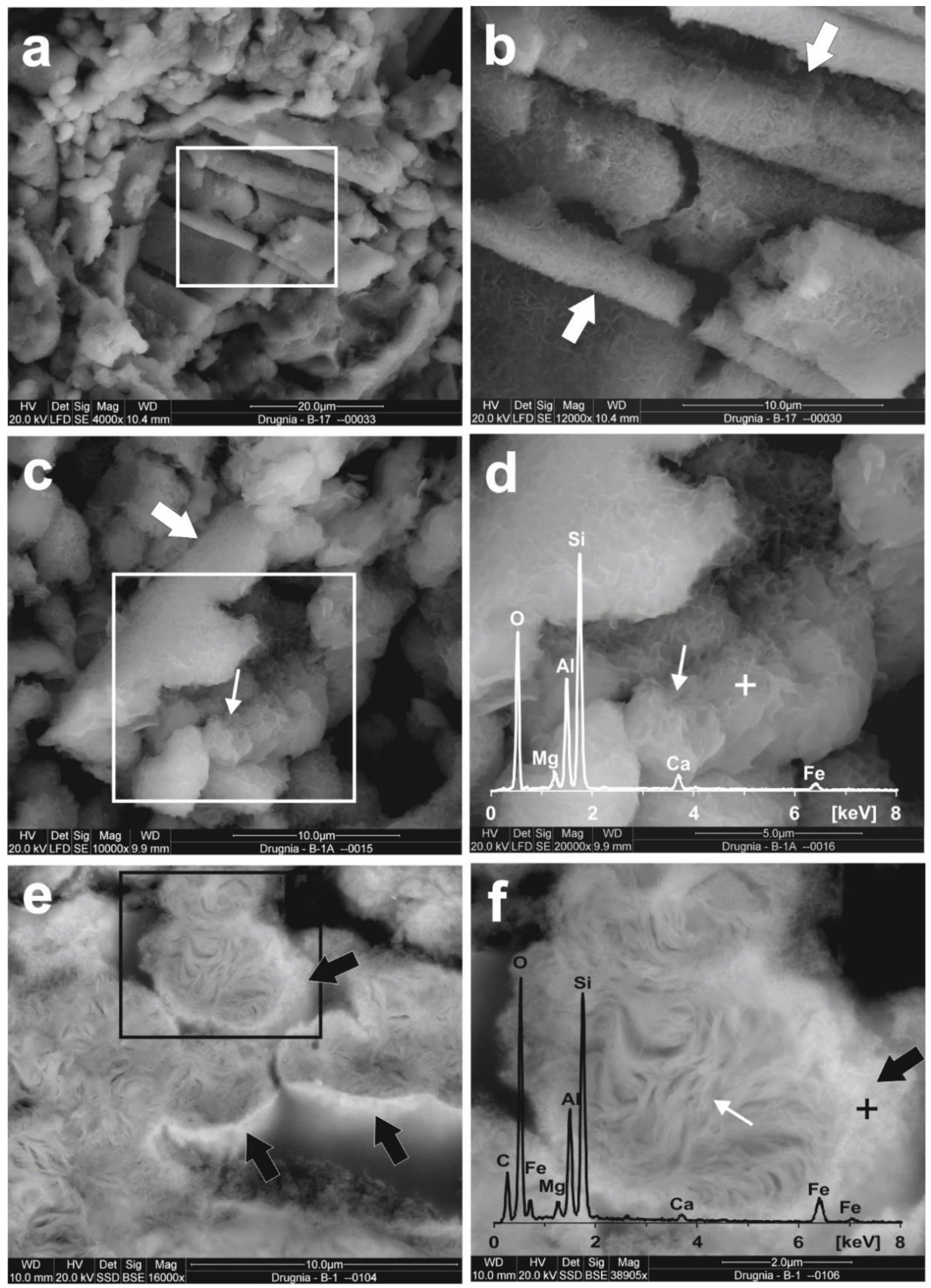

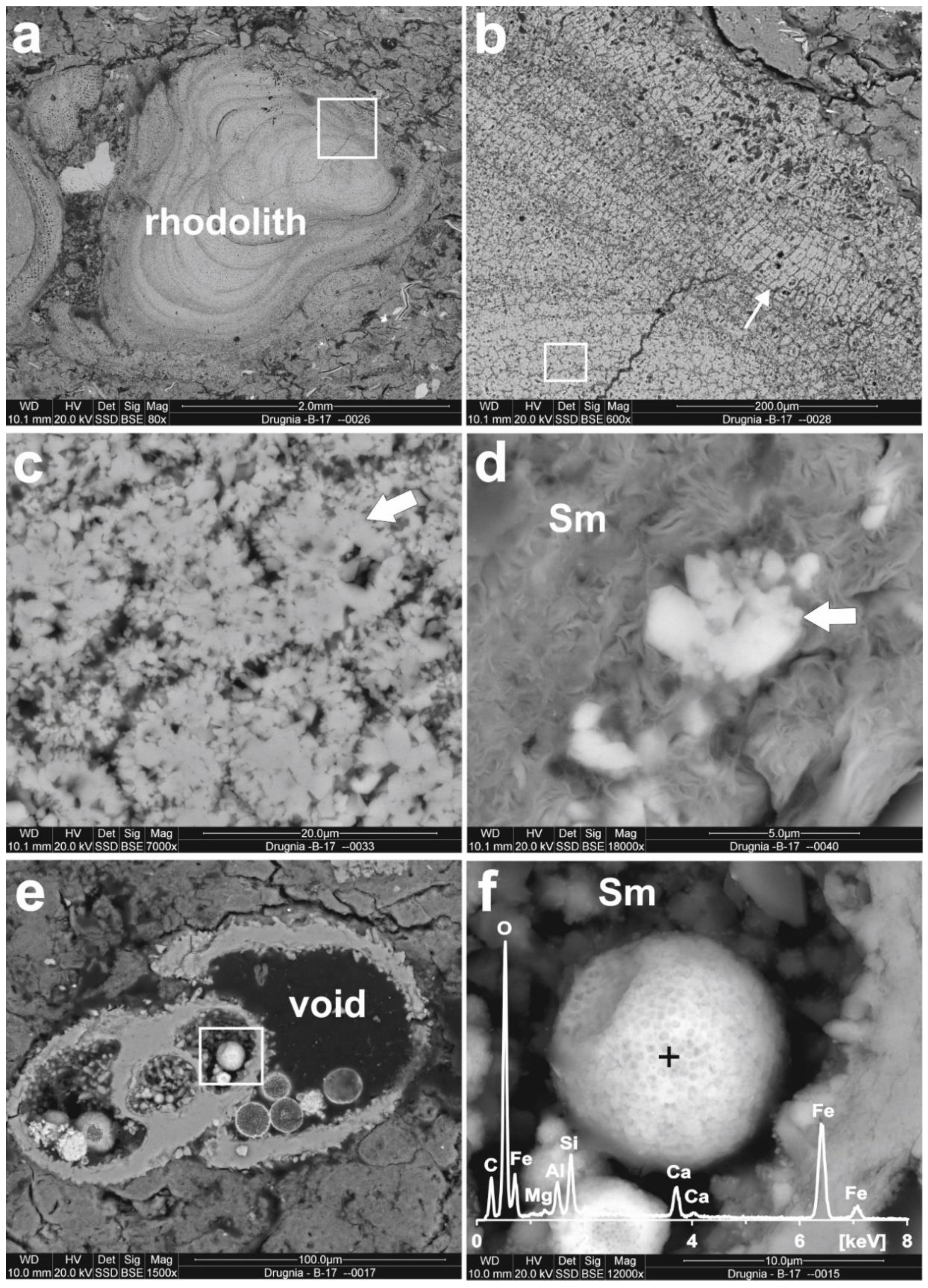
| Analyses | SiO2 | Al2O3 | Fe2O3 | MgO | CaO | Total | ||||||
|---|---|---|---|---|---|---|---|---|---|---|---|---|
| Sample B-1 | ||||||||||||
| Point 001 | 66.13 | 25.3 | 2.24 | 3.98 | 2.35 | 100.00 | ||||||
| Point 031 | 67.90 | 23.54 | 2.36 | 4.05 | 2.15 | 100.00 | ||||||
| Point 061 | 68.60 | 23.42 | 1.92 | 4.16 | 1.90 | 100.00 | ||||||
| Sample B-9 | ||||||||||||
| Point 022 | 68.60 | 22.14 | 1.64 | 4.12 | 1.92 | 100.00 | ||||||
| Point 031 | 67.51 | 22.14 | 2.55 | 4.27 | 3.53 | 100.00 | ||||||
| Point 032 | 66.51 | 23.11 | 4.47 | 4.04 | 1.87 | 100.00 | ||||||
| Point 057 | 68.13 | 21.67 | 2.59 | 5.88 | 1.73 | 100.00 | ||||||
| Sample B-17 | ||||||||||||
| Point 016 | 65.65 | 26.71 | 1.73 | 3.27 | 2.64 | 100.00 | ||||||
| Point 031 | 64.58 | 26.71 | 2.5 | 3.12 | 3.09 | 100.00 | ||||||
| Point 045 | 63.05 | 26.83 | 3.71 | 2.92 | 3.49 | 100.00 | ||||||
| Point 067 | 65.95 | 23.92 | 1.49 | 4.26 | 4.38 | 100.00 | ||||||
| Point 085 | 67.92 | 24.47 | 1.01 | 4.04 | 2.56 | 100.00 | ||||||
| Average | 66.71 | 24.29 | 2.35 | 4.01 | 2.63 | 100.00 | ||||||
| Averaged structural formulae based on 11 oxygen | ||||||||||||
| Si | AlIV | AlVI | Fe3+ | Mg | VI cations | Ca | Mg | Layer charge | Sum of the charges of the interlayer cations | |||
| 3.91 | 0.09 | 1.59 | 0.10 | 0.31 | 2.00 | 0.16 | 0.04 | 0.40 | 0.40 | |||
| Analyses | SiO2 | Al2O3 | Fe2O3 | TiO2 | MgO | K2O | Total |
|---|---|---|---|---|---|---|---|
| Sample B-1 | |||||||
| Point 020 | 47.15 | 16.6 | 18.19 | 3.73 | 9.02 | 5.31 | 100.00 |
| Point 065 | 45.28 | 16.17 | 18.83 | 4.10 | 8.80 | 6.82 | 100.00 |
| Point 091 | 45.88 | 15.76 | 18.44 | 3.95 | 9.19 | 6.77 | 100.00 |
| Point 111 | 48.63 | 17.90 | 19.04 | 4.01 | 8.98 | 1.45 | 100.00 |
| Point 113 | 47.71 | 16.60 | 16.14 | 3.73 | 9.23 | 6.58 | 100.00 |
| Point 117 | 43.38 | 16.29 | 19.83 | 4.39 | 9.08 | 7.02 | 100.00 |
| Sample B-9 | |||||||
| Point 004 | 46.43 | 16.11 | 17.34 | 3.87 | 9.26 | 6.99 | 100.00 |
| Sample B-17 | |||||||
| Point 061 | 46.31 | 15.47 | 18.23 | 3.88 | 8.54 | 7.57 | 100.00 |
| Point 068 | 44.12 | 15.83 | 18.53 | 4.09 | 9.37 | 8.06 | 100.00 |
Publisher’s Note: MDPI stays neutral with regard to jurisdictional claims in published maps and institutional affiliations. |
© 2021 by the authors. Licensee MDPI, Basel, Switzerland. This article is an open access article distributed under the terms and conditions of the Creative Commons Attribution (CC BY) license (https://creativecommons.org/licenses/by/4.0/).
Share and Cite
Górniak, K.; Szydłak, T.; Wyszomirski, P.; Gaweł, A.; Niemiec, M. Recently Discovered Thick Bentonite Bed Hosted by the Lithothamnium Limestones (Badenian) in the Polish Part of the Carpathian Foredeep: The Evidence for Volcanic Origin. Minerals 2021, 11, 1417. https://doi.org/10.3390/min11121417
Górniak K, Szydłak T, Wyszomirski P, Gaweł A, Niemiec M. Recently Discovered Thick Bentonite Bed Hosted by the Lithothamnium Limestones (Badenian) in the Polish Part of the Carpathian Foredeep: The Evidence for Volcanic Origin. Minerals. 2021; 11(12):1417. https://doi.org/10.3390/min11121417
Chicago/Turabian StyleGórniak, Katarzyna, Tadeusz Szydłak, Piotr Wyszomirski, Adam Gaweł, and Małgorzata Niemiec. 2021. "Recently Discovered Thick Bentonite Bed Hosted by the Lithothamnium Limestones (Badenian) in the Polish Part of the Carpathian Foredeep: The Evidence for Volcanic Origin" Minerals 11, no. 12: 1417. https://doi.org/10.3390/min11121417
APA StyleGórniak, K., Szydłak, T., Wyszomirski, P., Gaweł, A., & Niemiec, M. (2021). Recently Discovered Thick Bentonite Bed Hosted by the Lithothamnium Limestones (Badenian) in the Polish Part of the Carpathian Foredeep: The Evidence for Volcanic Origin. Minerals, 11(12), 1417. https://doi.org/10.3390/min11121417






